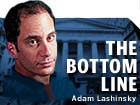
PALO ALTO, Calif. (CNN/Money) -
The Wall Street Journal apparently is shocked, shocked to have discovered that analyst pay is linked to investment-banking performance.
"While investment-banking work was always tracked in some way, such considerations were never hard and fast," the nation's business paper of record quoted brokerage industry executives saying in Monday's paper.
Before getting too hot and bothered about the naiveté in that statement, let's offer praise where it's due. Kudos to the Journal for unearthing damning contracts that show how explicit the relationship is between analyst coverage and the ability of investment banks to win corporate clients. (See more.)
Similarly damaging documents appeared in the New York Times over the weekend showing how Merrill Lynch's director of research asked analysts for detailed responses to a questionnaire demonstrating what each analyst had done for him lately in terms of generating banking bucks.
The thing is, the pay-for-performance has been going on for years. I recall having this explained to me in the early 1990s when I was covering the steel industry in Chicago. Analysts whose coverage helped the big investment banks win stock and bond deals were rewarded accordingly. It wasn't a secret.
Similarly, I recall a piece I did a couple years ago for another publication in which I quoted an analyst suggesting he wasn't all that interested in what the bankers had to say about his work. He called back after the article was posted to clarify. Of course he'd like to help generate banking business, he said. And would I mind excising the offending reference from the Web version of the article?
Two solutions
There are two approaches the industry and its regulators could take here. One is the ultimate caveat emptor argument, leaving it up to the public to take care of themselves. With full disclosure, everyone would understand that research departments are mostly advertising units for a firm's banking division, that their stock picks aren't to be relied upon for true investment advice and that analysts are best for their information rather than their opinions. It's a free-market cause that's been championed, predictably, by Holman Jenkins of the Wall Street Journal.
The other approach is to take radical action. It espouses ripping research groups from the banks, forcing the two to operate independently. It advocates punishing duplicitous analysts as a way for righting the wrongs they've perpetrated on non-institutional investors (otherwise known as individuals), who weren't in on the game. Gretchen Morgenson of the New York Times recently won a Pulitzer Prize for this line of attack.
I've been in the split-'em-up camp for about three years (I commented on the idea recently in "Calling for a Merrill Lynch break-up"). But I suppose the embarrass-the-hell-out-of-'em-and-then-leave-them-alone argument would work too, especially in these less-hyped times.
But please let's contain our "shock." There's been gambling going on here for quite some time now.
Seitel sliced
Things got worse Monday for Seitel. The Houston energy company, a librarian of seismic data used by other energy concerns searching for oil, has had a bevy of re-statements of late. On Friday the firm detailed its recent restatements, and on Monday it said it would sell $20 million worth of stock, at a discounted price, to unnamed investors in a private placement.
| |
 RECENTLY BY ADAM LASHINSKY
RECENTLY BY ADAM LASHINSKY
| |
| | |
| | |
|
As noted here last year, existing stockholders hate such sweetheart deals because someone else is getting in at a cheaper price and additional shares "dilute" earnings.
It's always worse when the seller doesn't disclose the identity of the buyer. Seitel (SEI: down $3.37 to $5.65, Research, Estimates) shares lost more than a third of their value on Monday, and are now down some 36 percent since April 1, the first time its story appeared in this space.
Adam Lashinsky is a senior writer for Fortune magazine. Send e-mail to Adam at adam_lashinsky@timeinc.com.
Sign up to receive The Bottom Line by e-mail.

|

